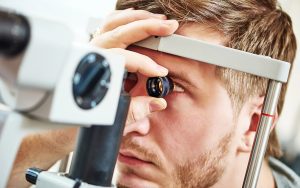Nystagmus: Types, Causes, Symptoms, Treatment

Do you ever experience involuntary, rapid eye movement of either or both eyes? And do the eye movements cause you some discomfort? You might be battling Nystagmus if you find it hard to control your eye movements and experience blurriness.
It is a rare condition due to underlying health and vision-related issues. Follow this helpful entry as it explores some of the causes, symptoms, and treatments of this eye condition.
What is Nystagmus?
Nystagmus is a condition that causes rapid, repetitive, uncontrolled movements. The condition does not cause any noticeable symptoms, making it very difficult to diagnose early. However, you may have the condition if you experience constant dizziness and vision problems with these eye movements.
The eyes could move:
- side to side (horizontal Nystagmus)
- up and down (vertical Nystagmus)
- in a circle (rotary Nystagmus)
Typically, Nystagmus arises from a neurological condition. It occurs when the part of the brain that regulates eye movements and positioning fails to function properly. In some instances, Nystagmus may develop as an already established neurological illness.
Causes Of Nystagmus
Nystagmus can be a symptom of an underlying health condition called benign paroxysmal positional vertigo— many individuals with nystagmus experience some problems with the brain. Benign paroxysmal positional vertigo makes the areas around the brain that should control eye movements and provide body balance malfunction, hence triggering Nystagmus.
Separately, Nystagmus indicates an underlying eye problem. Causes and risk factors include:
- Excessive use of alcohol or drugs
- Existing inner ear problems
- Head injuries, especially in younger people
- Susceptibility to strokes in adults
- A family with a history of Nystagmus
- Albinism
Nystagmus has an incidence rate of at least 1 in 1,000 people in the general population. Every gender, young and old, is susceptible to the condition.
Types Of Nystagmus
There are two main types of Nystagmus:
Congenital Nystagmus
This type of Nystagmus is more common in infants, usually between 6 weeks and three months old. Congenital Nystagmus in children affects both eyes and causes rapid and side-to-side movement of the affected eyes.
Many doctors believe this infant nystagmus is majorly inherited from parents and is difficult to prevent. Affected children do not see things or objects as shaking. Instead, they experience blurry vision that persists if left untreated.
Acquired Nystagmus
Unlike congenital Nystagmus, acquired Nystagmus comes later in life. It is, therefore, more common in adults– even more, prevalent in older adults. Children with congenital nystagmus experience blurry vision, while acquired Nystagmus in adults makes things around them look shaky.
Many things cause acquired Nystagmus. Common causes include serious medical conditions or drug and alcohol use.
Nystagmus in children and adults is not considered a serious condition by most doctors. But if the condition disrupts your vision, say when driving or crossing the street, then it is serious.
Another thing, some patients experience acute dizziness, which affects their work performance and social life. So, Nystagmus requires urgent medical attention.
Symptoms Of Nystagmus
The most common symptoms of Nystagmus in adults besides ‘jumping’ eyes include:
- Double or blurred vision that makes it difficult to see clearly
- Objects appear to be jumping
- Decreased body balance
- Vertigo– a feeling that the environment around you is spinning, or you are spinning
- Nausea
- Dizziness
Most people who have Nystagmus may experience almost all the above signals or some of them. The condition comes with complications such as:
- Decreased vision
- Poor balance
- Difficulty reading small prints
- Learning problems among children
- Lack of confidence, especially among children and adolescents.
- Fatigue due to the extra effort in reading and seeing.
How Is Nystagmus Diagnosed?
Only an ophthalmologist can ascertain whether you have symptoms of Nystagmus. An ophthalmologist will first get a detailed history of your condition, including prior eye-related conditions, underlying diseases, and any major events that preceded the onset of your symptoms.
Next, the ophthalmologist will take you through several eye examinations, including:
- Visual acuity test – including the near and distant vision without lens correction for individual and both eyes.
- Dilated eye exam – to check for retina and optic nerve defects.
- Slit lamp test – to check the eyelids, conjunctiva, cornea, iris, and lens. This test can determine if you have eye conditions like cataracts.
- Eye movement recordings – to determine the type of Nystagmus you may be experiencing. The ophthalmologist will use waveform patterns to determine this.
- Clinical tests – to diagnose the possible causes of nystagmus symptoms.
The ophthalmologist will recommend getting a brain MRI to determine the cause of Nystagmus if these tests do not show sufficient information for diagnosis and treatment.
Treatment Options For Nystagmus
Currently, there are no specific treatments or cures for Nystagmus. So, the ophthalmologist treats underlying conditions, such as childhood cataracts and strabismus. They can also advise on how to manage symptoms to improve everyday life.
Nystagmus in children does not require medical treatment because the child will outgrow the problem. Similarly, Nystagmus caused by medical conditions tends to disappear once the patient recovers.
The doctor will suggest using glasses or contact lenses when your vision becomes poor due to the condition. While using glasses cannot eliminate Nystagmus, they can improve vision. Contact lenses are usually the better choice since the lens will move along with the eyes.
But if you do not qualify for contacts, the doctor can include a prism in the glasses to help position the eye.
Some doctors recommend medications like gabapentin, memantine, and baclofen which paralyze the external eye muscles, leading to reduced symptoms. But the results are temporary, so you must keep up with the treatments.
Patients are encouraged to reduce their stress levels and take relaxation therapy since stress can worsen symptoms. Similarly, acupuncture has proved beneficial to some patients.
It is challenging to prevent Nystagmus. But identifying the underlying cause quickly can help treat the condition.
The Takeaway
Nystagmus, may not show any symptoms during its early stage. So as soon as you notice changes in your vision, you should consult with your doctor for a quick diagnosis. Visit our clinic today if you suspect you or your child has Nystagmus. We will be prompt in diagnosis and treatment options.




